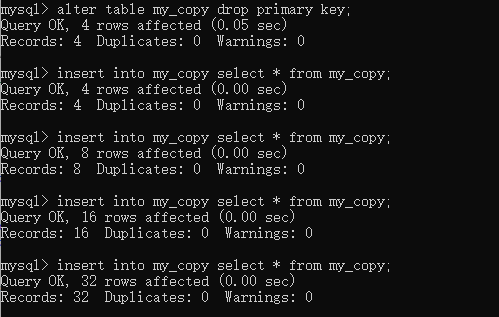mysql.exe -h localhost -P 3306 -u root -p
use mydb; —— 进入数据库
show tables; —— 查看所有表
查看:show index from 表名\G
desc:查看表结构
select * from 表名:查询所有数据
表创建的高级操作
从已有表创建新表(复制表结构):create table 表名 like 数据库.表名;
-- 复制创建表(只是复制了表结构)
create table my_copy like my_class;
蠕虫复制的意义
从已有表拷贝数据到新表中
可以迅速地让表中的数据膨胀到一定的数量级,用来测试表的压力以及效率
蠕虫复制
先查出数据,然后将查出的数据新增一遍
insert into 表名[(字段列表)] select 字段列表/* from 数据表名;
-- 蠕虫复制
insert into my_copy select * from my_class;
insert into my_copy select * from my_copy;
-- 删除主键
alter table my_copy drop primary key;
limit-truncate-select
更新数据
基本语法:update 表名 set 字段=值 [where条件];
高级语法:update 表名 set 字段=值 [where条件] [limit 更新数量];
-- 部分更新(前3个1811变成1911,其余不变)
update my_copy set name='Python1911' where name='Python1811' limit 3;
删除数据
delete from 表名 [where条件] [limit 数量];
truncate 表名; -- 先删除该表,后新增该表
-- 删除数据:限制记录数为5(前5个1903)
delete from my_copy where name='Python1903' limit 5;
如果表中存在主键自增长,那么当删除后将不会还原,将按原来的数自动往下增长
查看增长到几,用建表语句——show create table my_student;
数据的删除不会改变表结构
-- 给my_student表增加主键
alter table my_student modify id int primary key auto_increment;
-- 清空表:重置自增长(建议尽量不要随便使用)
truncate my_student;
查询数据
基本语法:select 字段列表/* from 表名 [where条件];
完整语法:select [select 选项] 字段列表[字段别名]/* from 数据源 [where条件子句] [group by子句] [having 子句] [order by子句] [limit 子句];
select 选项:select对查出来的结果的处理方式
all:默认的,保留所有的结果
distinct:去重,查出来的结果,将重复给去除
-- select 选项
select * from my_copy;
select all * from my_copy;
-- 去重
select distinct * from my_copy;
字段别名
字段名 [as] 别名;
-- 向学生表插入数据
insert into my_student
values (null,'bc20200001','张三','男'),
(null,'bc20200002','李四','男'),
(null,'bc20200003','王五','女'),
(null,'bc20200004','赵六','男'),
(null,'bc20200005','小明','男');
-- 字段别名
select id, number as 学号, name as 姓名,
sex 性别 from my_student;
别名-数据源
数据源:单表数据源、多表数据源、查询语句
单表数据源:select * from 表名;
-- 单表数据源
select * from my_student;
多表数据源:select * from 表名1,表名2, ...;
-- 多表数据源
select * from my_student,my_class;
子查询:select * from (select 语句) as 别名;
-- 子查询
select * from (select * from my_student) as s;
where子句
where原理:唯一一个直接从磁盘获取数据的时候就开始判断条件,也就是说where之后的都不是操作磁盘上的数据,而是读到内存,都是在操作内存上的数据(保证放到内存里的数据都是合理的)
where子句:返回结果0或1,0代表false,1代表true
判断条件
比较运算符:>、<、>=、<=、!=、<>、=、like、between、and、in/not in
逻辑运算符:&&(and)、||(or)、!(not)
-- 增加age年龄和height身高字段
alter table my_student add age tinyint unsigned;
alter table my_student add height tinyint unsigned;
-- 增加字段值:rend取得一个0~1之间的随机数,floor向下取整
update my_student set age=floor(rand() *20+20),height=floor(rand() *20+170);
-- 找学生id为1、3、5的学生(以下两种方法查出结果一样)
select * from my_student where id=1 || id=3 || id=5;-- 逻辑判断
select * from my_student where id in(1,3,5);-- 落在集合当中
-- 找身高在185~190之间的学生(以下两种方法查出结果一样)(左边必须<=右边的值)
select * from my_student where height>=185 and height<=190;
select * from my_student where height between 185 and 190;
select * from my_student where height between 190 and 185;-- 系统识别不出来
select * from my_student where 1; -- 所有条件都满足
group by子句
基本语法:group by 字段名 [asc|desc];
统计函数:(重点,必会)
count():统计分组后的记录数,每一组有多少记录
max():统计每组中最大的值
min():统计最小值
avg():统计平均值
sum():统计和
-- 根据性别分组
select * from my_student group by sex;
-- 分组统计:身高高矮、平均年龄、总年龄
select sex,count(*),max(height),min(height),avg(age),sum(age) from my_student group by sex;
-- 修改id为4的记录,把年龄置位NULL
update my_student set age=null where id=4;
select sex,count(*),count(age),max(height),min(height),avg(age),sum(age) from my_student group by sex;
将count(*)与count(age)进行比较,count(age)里没有记录为null的那条
-- 修改id为1的记录,把性别置为女
update my_student set sex='女' where id=1;
-- nan nv 按拼音排序,默认升序
-- 倒序(desc)
select sex,count(*), count(age),max(height),min(height),avg(age),sum(age) from my_student group by sex desc;
-- 删除班级表主键
alter table my_class drop primary key;
-- 给班级表增加主键id
alter table my_class add id int primary key auto_increment;
-- 给学生表增加一个班级表的id
alter table my_student add c_id int;
update my_student set c_id=ceil(rand() *4);-- ceil天花板,向上取整
-- 中途插一条
insert into my_student values(6,'bc20200006','小芳','女',18,160,2);
-- 多字段分组,先班级,后男女(用在group by后面,只能用having)
select c_id,sex,count(*) from my_student group by c_id,sex; -- 多字段排序
多字段排序
group_concat(字段);
-- 分组的结果中的某个字段进行字符串的连接(保留这个组的所有字段)
select c_id,sex,count(*),group_concat(name) from my_student group by c_id,sex;








